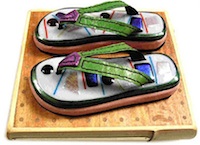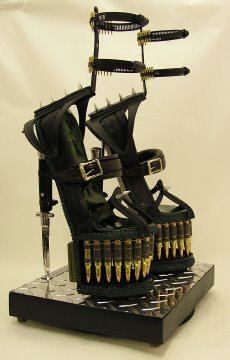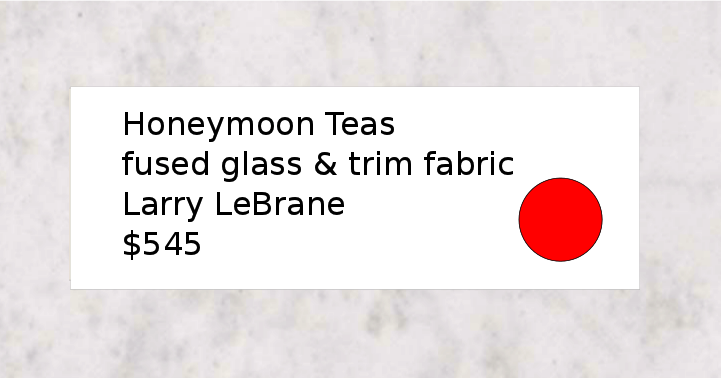This Little Light of Mine

It's true that more opportunity to expose your creativity exists today than at any time in history. The internet has opened doors that were unimaginable only a decade or two ago. You literally have millions of potential customers at your fingertips, whether you are selling your art, your music, your stock picking system, your sure fire weight loss program, or whatever you can imagine. The people who would truly benefit from what you've got are out there in numbers you can barely conceive of. And the internet is full of advice on how to get them to beat down your door. It seems like it would be easy. People spend a remarkable amount of time each day glued to their web browsers in search of just that piece of information that they believe they need to make their lives better in some way. Search engines and social media dominate the web, with millions of web sites and email campaigns vying for a spot in your busy day, and for a path from your casual interest to your wallet.
On the surface it seems like it would be easy to reach the right people to connect with what you have to offer. A tiny fraction of the millions of people on the internet buying what you have to sell could change your life in profound ways. And yet, one of the most difficult things to do these days is to get anybody's attention on line. We are all bombarded with wave after wave of email, text messages, and million hit searches on a moment by moment basis. Even the things that we would normally value tend to be swept aside simply because we cannot process them all. Your web presence as a promoter of your work is like a flashlight with two double A batteries turned on and pointing directly into the sun. There is simply too much information, too many web sites, too much opportunity all around you in cyberspace for your tiny beacon to make a difference.
Of course you must have a web site for your craft. You must be there when a potential buyer tries to find you on line. The fact that you are a needle randomly buried in a million acre warehouse full of hay is not reason to throw up your hands in despair. Rather, it is reason to evaluate what you think the internet is, and how you can best position it in the toolbox of your marketing strategy. You do have a marketing strategy, yes? Your marketing strategy does engage the internet, yes?

Taking our analogy of the flashlight pointed at the sun a step further, a single candle, dimmer even than our flashlight, in a dark room would be bright, and impossible to ignore. What makes the difference? Contrast, of course. the problem with internet marketing is simply that there is too much of it and it is all essentially alike. When you are standing in a highly illuminated white room where everything in the room is white and everything is competing to be whiter and brighter than everything else, it only takes one flat black object introduced into the room to suck all the attention away from the whiteness. The key is contrast.
The Phantom Project, which we have discussed before in OTL, illustrates this point nicely. Virtually all the publicity for our first show was achieved via Facebook in less than two months time. All the galleries and art organizations in our community have a presence on the web, including at the minimum a web site and a facebook page. Yet rarely do any of these web tools serve to mobilize the art community with the kind of energy we achieved, and on such short notice.
 What made the difference? More than anything else, it was that our idea was different, and it was dramatic and it filled a void that was not being addressed in the flood of input from all of the usual players in the gallery game. We got noticed because we were the black lamb in a flock of white sheep. It worked for us. But once we become established, once the community becomes accustomed to black lambs, we will not get the same energy simply from being the black lamb.
What made the difference? More than anything else, it was that our idea was different, and it was dramatic and it filled a void that was not being addressed in the flood of input from all of the usual players in the gallery game. We got noticed because we were the black lamb in a flock of white sheep. It worked for us. But once we become established, once the community becomes accustomed to black lambs, we will not get the same energy simply from being the black lamb.
Of course being unique and different is an obvious key to success in the vast sea of internet exposure, but it doesn't substitute for quality and energy and integrity. These things are background necessities. If all you've got is a gimmick to set you apart, you won't get far for very long. What sets you apart must be solid and it must have what architects call "good bones." It must be rooted in your core vision for your work. It will take work for you to find the ways that you stand out, and to learn how to convey that to your public. All of us struggle with this challenge every day. And solving it today does not excuse you from tackling it tomorrow. This is the most difficult and consistent challenge that you must meet, and you must meet it while staying grounded in your core calling as a creator. And you can do it!
Sales Versus Exposure
In our February interview, we talked to Larry LeBrane about the relative value of a quick sale as compared to exposure.

Larry: I’ll give you a story. I did a pair of shoes, glass flip flops when I was doing flip flops. I finished them on a Friday and I was showing them on a Sunday at Dinosaur Caves. The show goes from 10:00 to 4:00 and this woman walks up and says, “I love those shoes, I want to buy them.” This was at 10:15. I had just opened. I said, "ok, I’ll sell them to you but I can’t give them to you until 4:00. I just finished them and nobody’s seen them. I want people to see them. So the money wasn’t really . . . I said I want more exposure, exposure’s more important than the money at that point. She said ok, she gave me a check and said I’ll be back at 4:00. So meanwhile, halfway through the day, another guy comes along and he says “I want those shoes.” I said I sold them but I can make another pair, but they won’t be just like that pair. I said, "they’ll be crazy like that. You tell me what colors you want, and I’ll make another pair." So he said ok. Meanwhile I’d been talking to Ronda about it and Ronda pipes up, “He’s thinking of making high heels next!” He said, “oh, tell me about it.” He asked what I was going to use for the base. I said I had this diamond plate aluminum that looks pretty cool. He said, "Oh great, I’m lining my garage in that stuff!" He has a house in Shell Beach. He’s in the oil industry in Bakersfield. He's got a house in Tahoe, he’s got a plane, he calls the pilot to fly him to SLO, so he can smoke his cigar and drink wine. I never would have had this conversation if I had let the woman take her flip flops at 10:15.

Anyway, I finished the shoes for him and started working on the high heels, so we go to his house to show him the high heels I'm working on. His house is right on Ocean Avenue on the cliff of Shell Beach. The cliff is right across the street. So we go in the house and there’s the pair of shoes, sitting on the floor like a doorstop. But it’s white tile, white carpet leading to the living room and the shoes are there and it tells you “take off your shoes” without saying a word. It’s a hint. That’s where the shoes go, take them off. That was so cool. At first I thought, why’s it sitting on the floor but then I got it.
Peggy: He just walked by at the right time at Dinosaur Caves.
Michael: So if you had sold her the shoes let her take them home none of that would have happened.
Larry: Yes. I finished the stilettos and I said, I want people to see them, no one else has seen them so I want to borrow these for awhile and enter them in shows and stuff because that was more important.
Michael: So you just never know when it’s going to lead to something.
Larry: Exactly. You know the exposure is worth more than a quick sale. So just like with these shoes, I had the stilettos for a year, showed them around, and at the end of the year he bought them. Which was fine. if he hadn't, it would have been fine. I had the exposure, I became the shoe guy.
Larry makes and illustrates a very important point for artists. As much as we cherish the thought of selling our work, it's really important to keep the bigger picture clearly in mind. If your work is well established, and there are numerous examples of it out in the public view, and if you are not introducing new directions and innovations, then perhaps the quick sale should be at the top of your priorities. (And right below that priority should come the question: "Why am I not innovating." But stagnation is not the topic for this article. We will address that another day.)
If on the other hand, you are innovating, and introducing new concepts, media, or techniques into your work, then it behooves you to show the new work in the brightest light possible. Sometimes this means, as in Larry's case, that you forestall the quick sale, or at least the quick delivery of the new work so that you can maximize its exposure.
In Larry's case, the glass flip-flops were delivered at the end of the day, and the exposure afforded by that brief delay was enough to get him another sale of flip-flops and to launch him headlong into his now famous stilettos, a fresh new idea that he had only been thinking about up to that point. And then, when he made the first set of stilettos on consignment, he arranged to keep them to show for a year before delivery. As a result, in his own words, "I became the shoe guy."
Building expectations and anticipation with your public is very imnportant for the advancement of your art and your career as an artist. People rarely are smitten to the point of opening their wallets and their hearts to an idea the first time they encounter it. This happens now and then, but in general, people need to warm to an idea with repeated positive exposure. In the marketing world  there is an old saw that the public generally does not respond to a new idea until that idea has touched them seven times. If you have a hot new idea, one that sells easily, and you sell it and let it go before you have a chance to show it, you are missing an opportunity to launch that idea to a higher level. Add to this the fact that when someone is impressed by your work, and then notices that it has that coveted red dot sold sticker on its gallery label, that further reinforces the impression of value for the work.
there is an old saw that the public generally does not respond to a new idea until that idea has touched them seven times. If you have a hot new idea, one that sells easily, and you sell it and let it go before you have a chance to show it, you are missing an opportunity to launch that idea to a higher level. Add to this the fact that when someone is impressed by your work, and then notices that it has that coveted red dot sold sticker on its gallery label, that further reinforces the impression of value for the work.
Of course we are not suggesting that you turn down sales. That would be crazy. What we are suggesting is that whenever possible, you ensure that your work has ample exposure, and that you are prepared to follow it with more in the same vein, before you let it slip into the cloistered environs of a private setting. Negotiate with the buyer for a later delivery date, or for them to allow you to show the work in future shows, identifying it as "from the private collection of..."
This technique of borrowing work back from your buyers to show can be beneficial to you, your buyer, and the viewing public. It allows you to show the work without risking the loss of a sale. It also telegraphs to your viewing public that your work sells. And it gives your buyer an ego boost. When their name is on the tag in place of a price, it telegraphs the message to all viewers, "Yes, I own that piece. I'm an art collector, and it is through my generosity that you get to see this piece." And finally, showing art that has sold already allows your viewing public the chance to see work that would otherwise be hidden away in a private residence, exposing them to what you are doing, and creating the anticipation of more to come.
Steal Like an Artist
  Now and then something comes along that we like so much that it's hard to contain ourselves. Steal Like an Artist: 10 Things Nobody Told You About Being Creative
Now and then something comes along that we like so much that it's hard to contain ourselves. Steal Like an Artist: 10 Things Nobody Told You About Being Creative is one of those things. The book hasn't yet been released for publication, and normally we would wait until we can actually read the whole book before recommending it. But we liked the preview excerpt so much that we had to share it with you now.
is one of those things. The book hasn't yet been released for publication, and normally we would wait until we can actually read the whole book before recommending it. But we liked the preview excerpt so much that we had to share it with you now.
As far as we can tell from the preview, the book is about the idea that as artists, and as creative beings, we are heavily dependent on what has been done before for our inspiration and ideas. The author, Austin Kleon, makes much of the notion that creativity never happens in a vacuum and the idea of originality is overrated. He claims, with a very positive spin, that all art is plagiarism. He makes the case that everything worth doing has been done, and needs to be done again, this time with your own spin that puts it in a fresh light. We usually refer to this process euphemistically as "influence," but Kleon comes right out and says that theft is a better word for it. But his slant on what this means is positive, inspired, and refreshing. The price is right at only $5.82 on Amazon, and we think this could turn out to be one of those classics like The War of Art, by Steven Pressfield .
We can't wait for the release date on February 26! in the mean time, you can read a preview excerpt by following the "search inside" link at the book page linked above. .
We can't wait for the release date on February 26! in the mean time, you can read a preview excerpt by following the "search inside" link at the book page linked above.
|



 What made the difference? More than anything else, it was that our idea was different, and it was dramatic and it filled a void that was not being addressed in the flood of input from all of the usual players in the gallery game. We got noticed because we were the black lamb in a flock of white sheep. It worked for us. But once we become established, once the community becomes accustomed to black lambs, we will not get the same energy simply from being the black lamb.
What made the difference? More than anything else, it was that our idea was different, and it was dramatic and it filled a void that was not being addressed in the flood of input from all of the usual players in the gallery game. We got noticed because we were the black lamb in a flock of white sheep. It worked for us. But once we become established, once the community becomes accustomed to black lambs, we will not get the same energy simply from being the black lamb.


 there is an old saw that the public generally does not respond to a new idea until that idea has touched them seven times. If you have a hot new idea, one that sells easily, and you sell it and let it go before you have a chance to show it, you are missing an opportunity to launch that idea to a higher level. Add to this the fact that when someone is impressed by your work, and then notices that it has that coveted red dot sold sticker on its gallery label, that further reinforces the impression of value for the work.
there is an old saw that the public generally does not respond to a new idea until that idea has touched them seven times. If you have a hot new idea, one that sells easily, and you sell it and let it go before you have a chance to show it, you are missing an opportunity to launch that idea to a higher level. Add to this the fact that when someone is impressed by your work, and then notices that it has that coveted red dot sold sticker on its gallery label, that further reinforces the impression of value for the work.


